MA3-923
antibody from Invitrogen Antibodies
Targeting: ATP4B
ATP6B
 Western blot
Western blot Immunocytochemistry
Immunocytochemistry Immunoprecipitation
Immunoprecipitation Immunohistochemistry
Immunohistochemistry Flow cytometry
Flow cytometry Chromatin Immunoprecipitation
Chromatin Immunoprecipitation Other assay
Other assayAntibody data
- Antibody Data
- Antigen structure
- References [67]
- Comments [0]
- Validations
- Immunocytochemistry [6]
- Immunohistochemistry [2]
- Other assay [14]
Submit
Validation data
Reference
Comment
Report error
- Product number
- MA3-923 - Provider product page

- Provider
- Invitrogen Antibodies
- Product name
- ATP4B Monoclonal Antibody (2G11)
- Antibody type
- Monoclonal
- Antigen
- Synthetic peptide
- Description
- MA3-923 detects the beta-subunit of hydrogen/potassium ATPase from bovine, human, canine, porcine, rabbit, mouse, ferret, and rat tissues. MA3-923 has been successfully used in Western blot, immunohistochemistry, immunocytochemistry, and immunoprecipitation procedures (ChIP). By Western blot, this antibody detects various forms of the beta-subunit, including a 60 to 80 kDa glycosylated protein, a 52 kDa beta-subunit precursor, and the 34 kDa core peptide from rabbit stomach extracts. Immunohistochemical staining of hydrogen/potassium ATPase in rabbit gastric glands with MA3-923 results in specific staining of parietal cells. MA3-923 has been shown to inhibit the enzymatic activity of the hydrogen/potassium ATPase and to alter the affinity of the cytoplasmic potassium binding site. The MA3-923 antigen is purified 34 kDa core peptide from deglycosylated hog gastric microsomes. This antibody recognizes an epitope between amino acid residues 1-13 or 15-28 located on the cytoplasmic side of the beta-subunit.
- Reactivity
- Human, Mouse, Rat, Bovine, Canine, Porcine, Rabbit
- Host
- Mouse
- Isotype
- IgG
- Antibody clone number
- 2G11
- Vial size
- 100 μL
- Concentration
- Conc. Not Determined
- Storage
- -20°C, Avoid Freeze/Thaw Cycles
Submitted references Roles for H(+) /K(+) -ATPase and zinc transporter 3 in cAMP-mediated lysosomal acidification in bafilomycin A1-treated astrocytes.
Stomach secretes estrogen in response to the blood triglyceride levels.
Identification of key methylation differentially expressed genes in posterior fossa ependymoma based on epigenomic and transcriptome analysis.
HER2-Specific Targeted Toxin DARPin-LoPE: Immunogenicity and Antitumor Effect on Intraperitoneal Ovarian Cancer Xenograft Model.
Immunohistochemistry in Investigative and Toxicologic Pathology.
The cytoprotective protein clusterin is overexpressed in hypergastrinemic rodent models of oxyntic preneoplasia and promotes gastric cancer cell survival.
Troy is expressed in human stomach mucosa and a novel putative prognostic marker of intestinal type gastric cancer.
The Development of Spasmolytic Polypeptide/TFF2-Expressing Metaplasia (SPEM) During Gastric Repair Is Absent in the Aged Stomach.
PAI-1 deficiency increases the trophic effects of hypergastrinemia in the gastric corpus mucosa.
GATA4 and GATA6 regulate pancreatic endoderm identity through inhibition of hedgehog signaling.
Airway acidification initiates host defense abnormalities in cystic fibrosis mice.
Helicobacter pylori-induced Sonic Hedgehog expression is regulated by NFκB pathway activation: the use of a novel in vitro model to study epithelial response to infection.
CD44 plays a functional role in Helicobacter pylori-induced epithelial cell proliferation.
The use of murine-derived fundic organoids in studies of gastric physiology.
Modelling human development and disease in pluripotent stem-cell-derived gastric organoids.
Myosin IIB and F-actin control apical vacuolar morphology and histamine-induced trafficking of H-K-ATPase-containing tubulovesicles in gastric parietal cells.
The gastrin receptor antagonist netazepide (YF476) prevents oxyntic mucosal inflammation induced by Helicobacter pylori infection in Mongolian gerbils.
Acid secretion-associated translocation of KCNJ15 in gastric parietal cells.
Parietal cell activation by arborization of ECL cell cytoplasmic projections is likely the mechanism for histamine induced secretion of hydrochloric acid.
Genetic dissection reveals unexpected influence of beta subunits on KCNQ1 K+ channel polarized trafficking in vivo.
K-ras mutation targeted to gastric tissue progenitor cells results in chronic inflammation, an altered microenvironment, and progression to intraepithelial neoplasia.
Impaired gastric gland differentiation in Peutz-Jeghers syndrome.
ERRgamma regulates cardiac, gastric, and renal potassium homeostasis.
Loss of parietal cell expression of Sonic hedgehog induces hypergastrinemia and hyperproliferation of surface mucous cells.
A possible mechanism for ezrin to establish epithelial cell polarity.
Pioglitazone induced gastric acid secretion.
Cyclopamine inhibition of the sonic hedgehog pathway in the stomach requires concomitant acid inhibition.
Transcription factors GATA-4 and GATA-6 in normal and neoplastic human gastrointestinal mucosa.
Modulatory role of phosphoinositide 3-kinase in gastric acid secretion.
Long slender cytoplasmic extensions: a common feature of neuroendocrine cells?
DeltaF508 mutation results in impaired gastric acid secretion.
In situ measurement of pH in the secreting canaliculus of the gastric parietal cell and adjacent structures.
Signet ring cells in gastric carcinomas are derived from neuroendocrine cells.
Decreased basal mucus secretion by Slp2-a-deficient gastric surface mucous cells.
The KCNE2 potassium channel ancillary subunit is essential for gastric acid secretion.
COUP-TFII is essential for radial and anteroposterior patterning of the stomach.
Achlorhydria by ezrin knockdown: defects in the formation/expansion of apical canaliculi in gastric parietal cells.
Overexpression of glycine-extended gastrin inhibits parietal cell loss and atrophy in the mouse stomach.
Role of adenosine A2A receptor in the regulation of gastric somatostatin release.
ECL-cell derived gastric cancer in male cotton rats dosed with the H2-blocker loxtidine.
Identification of the beta-subunit for nongastric H-K-ATPase in rat anterior prostate.
Neuroendocrine tumor markers and enterochromaffin-like cell hyper/dysplasia in type 1 diabetes.
High-pressure freezing of isolated gastric glands provides new insight into the fine structure and subcellular localization of H+/K+-ATPase in gastric parietal cells.
High-pressure freezing of isolated gastric glands provides new insight into the fine structure and subcellular localization of H+/K+-ATPase in gastric parietal cells.
Rab9 GTPase regulates late endosome size and requires effector interaction for its stability.
Role of adenosine A1 receptor in the regulation of gastrin release.
Myosin II is present in gastric parietal cells and required for lamellipodial dynamics associated with cell activation.
Identification and regulation of the gastric H+/K+-ATPase in the rat heart.
Autoimmune gastropathy in type 1 diabetic patients with parietal cell antibodies: histological and clinical findings.
Demonstration of a functional apical sodium hydrogen exchanger in isolated rat gastric glands.
Sonic hedgehog expression correlates with fundic gland differentiation in the adult gastrointestinal tract.
Localization and function of soluble N-ethylmaleimide-sensitive factor attachment protein-25 and vesicle-associated membrane protein-2 in functioning gastric parietal cells.
PACAP stimulates gastric acid secretion in the rat by inducing histamine release.
Catalytic function of nongastric H,K-ATPase expressed in Sf-21 insect cells.
Functionally distinct pools of actin in secretory cells.
Functionally distinct pools of actin in secretory cells.
Clathrin in gastric acid secretory (parietal) cells: biochemical characterization and subcellular localization.
Clathrin in gastric acid secretory (parietal) cells: biochemical characterization and subcellular localization.
Gastrin has a specific proliferative effect on the rat enterochromaffin-like cell, but not on the parietal cell: a study by elutriation centrifugation.
Octreotide inhibits the enterochromaffin-like cell but not peroxisome proliferator-induced hypergastrinemia.
Octreotide inhibits the enterochromaffin-like cell but not peroxisome proliferator-induced hypergastrinemia.
Expression of rab11a N124I in gastric parietal cells inhibits stimulatory recruitment of the H+-K+-ATPase.
Expression of rab11a N124I in gastric parietal cells inhibits stimulatory recruitment of the H+-K+-ATPase.
K depletion stimulates in vivo HCO3 reabsorption in surviving rat distal tubules.
Receptor extracellular domains may contain trafficking information. Studies of the 300-kDa mannose 6-phosphate receptor.
Characterization of the beta-subunit of the H(+)-K(+)-ATPase using an inhibitory monoclonal antibody.
Characterization of the beta-subunit of the H(+)-K(+)-ATPase using an inhibitory monoclonal antibody.
Lee H, Koh JY
Glia 2021 May;69(5):1110-1125
Glia 2021 May;69(5):1110-1125
Stomach secretes estrogen in response to the blood triglyceride levels.
Ito T, Yamamoto Y, Yamagishi N, Kanai Y
Communications biology 2021 Dec 7;4(1):1364
Communications biology 2021 Dec 7;4(1):1364
Identification of key methylation differentially expressed genes in posterior fossa ependymoma based on epigenomic and transcriptome analysis.
Wang G, Jia Y, Ye Y, Kang E, Chen H, Wang J, He X
Journal of translational medicine 2021 Apr 26;19(1):174
Journal of translational medicine 2021 Apr 26;19(1):174
HER2-Specific Targeted Toxin DARPin-LoPE: Immunogenicity and Antitumor Effect on Intraperitoneal Ovarian Cancer Xenograft Model.
Sokolova EA, Shilova ON, Kiseleva DV, Schulga AA, Balalaeva IV, Deyev SM
International journal of molecular sciences 2019 May 15;20(10)
International journal of molecular sciences 2019 May 15;20(10)
Immunohistochemistry in Investigative and Toxicologic Pathology.
Janardhan KS, Jensen H, Clayton NP, Herbert RA
Toxicologic pathology 2018 Jul;46(5):488-510
Toxicologic pathology 2018 Jul;46(5):488-510
The cytoprotective protein clusterin is overexpressed in hypergastrinemic rodent models of oxyntic preneoplasia and promotes gastric cancer cell survival.
Vange P, Bruland T, Doseth B, Fossmark R, Sousa MML, Beisvag V, Sørdal Ø, Qvigstad G, Waldum HL, Sandvik AK, Bakke I
PloS one 2017;12(9):e0184514
PloS one 2017;12(9):e0184514
Troy is expressed in human stomach mucosa and a novel putative prognostic marker of intestinal type gastric cancer.
Wilhelm F, Böger C, Krüger S, Behrens HM, Röcken C
Oncotarget 2017 Aug 1;8(31):50557-50569
Oncotarget 2017 Aug 1;8(31):50557-50569
The Development of Spasmolytic Polypeptide/TFF2-Expressing Metaplasia (SPEM) During Gastric Repair Is Absent in the Aged Stomach.
Engevik AC, Feng R, Choi E, White S, Bertaux-Skeirik N, Li J, Mahe MM, Aihara E, Yang L, DiPasquale B, Oh S, Engevik KA, Giraud AS, Montrose MH, Medvedovic M, Helmrath MA, Goldenring JR, Zavros Y
Cellular and molecular gastroenterology and hepatology 2016 Sep;2(5):605-624
Cellular and molecular gastroenterology and hepatology 2016 Sep;2(5):605-624
PAI-1 deficiency increases the trophic effects of hypergastrinemia in the gastric corpus mucosa.
Fossmark R, Rao S, Mjønes P, Munkvold B, Flatberg A, Varro A, Thommesen L, Nørsett KG
Peptides 2016 May;79:83-94
Peptides 2016 May;79:83-94
GATA4 and GATA6 regulate pancreatic endoderm identity through inhibition of hedgehog signaling.
Xuan S, Sussel L
Development (Cambridge, England) 2016 Mar 1;143(5):780-6
Development (Cambridge, England) 2016 Mar 1;143(5):780-6
Airway acidification initiates host defense abnormalities in cystic fibrosis mice.
Shah VS, Meyerholz DK, Tang XX, Reznikov L, Abou Alaiwa M, Ernst SE, Karp PH, Wohlford-Lenane CL, Heilmann KP, Leidinger MR, Allen PD, Zabner J, McCray PB Jr, Ostedgaard LS, Stoltz DA, Randak CO, Welsh MJ
Science (New York, N.Y.) 2016 Jan 29;351(6272):503-7
Science (New York, N.Y.) 2016 Jan 29;351(6272):503-7
Helicobacter pylori-induced Sonic Hedgehog expression is regulated by NFκB pathway activation: the use of a novel in vitro model to study epithelial response to infection.
Schumacher MA, Feng R, Aihara E, Engevik AC, Montrose MH, Ottemann KM, Zavros Y
Helicobacter 2015 Feb;20(1):19-28
Helicobacter 2015 Feb;20(1):19-28
CD44 plays a functional role in Helicobacter pylori-induced epithelial cell proliferation.
Bertaux-Skeirik N, Feng R, Schumacher MA, Li J, Mahe MM, Engevik AC, Javier JE, Peek RM Jr, Ottemann K, Orian-Rousseau V, Boivin GP, Helmrath MA, Zavros Y
PLoS pathogens 2015 Feb;11(2):e1004663
PLoS pathogens 2015 Feb;11(2):e1004663
The use of murine-derived fundic organoids in studies of gastric physiology.
Schumacher MA, Aihara E, Feng R, Engevik A, Shroyer NF, Ottemann KM, Worrell RT, Montrose MH, Shivdasani RA, Zavros Y
The Journal of physiology 2015 Apr 15;593(8):1809-27
The Journal of physiology 2015 Apr 15;593(8):1809-27
Modelling human development and disease in pluripotent stem-cell-derived gastric organoids.
McCracken KW, Catá EM, Crawford CM, Sinagoga KL, Schumacher M, Rockich BE, Tsai YH, Mayhew CN, Spence JR, Zavros Y, Wells JM
Nature 2014 Dec 18;516(7531):400-4
Nature 2014 Dec 18;516(7531):400-4
Myosin IIB and F-actin control apical vacuolar morphology and histamine-induced trafficking of H-K-ATPase-containing tubulovesicles in gastric parietal cells.
Natarajan P, Crothers JM Jr, Rosen JE, Nakada SL, Rakholia M, Okamoto CT, Forte JG, Machen TE
American journal of physiology. Gastrointestinal and liver physiology 2014 Apr 15;306(8):G699-710
American journal of physiology. Gastrointestinal and liver physiology 2014 Apr 15;306(8):G699-710
The gastrin receptor antagonist netazepide (YF476) prevents oxyntic mucosal inflammation induced by Helicobacter pylori infection in Mongolian gerbils.
Sørdal Ø, Waldum H, Nordrum IS, Boyce M, Bergh K, Munkvold B, Qvigstad G
Helicobacter 2013 Dec;18(6):397-405
Helicobacter 2013 Dec;18(6):397-405
Acid secretion-associated translocation of KCNJ15 in gastric parietal cells.
He W, Liu W, Chew CS, Baker SS, Baker RD, Forte JG, Zhu L
American journal of physiology. Gastrointestinal and liver physiology 2011 Oct;301(4):G591-600
American journal of physiology. Gastrointestinal and liver physiology 2011 Oct;301(4):G591-600
Parietal cell activation by arborization of ECL cell cytoplasmic projections is likely the mechanism for histamine induced secretion of hydrochloric acid.
Gustafsson BI, Bakke I, Hauso Ø, Kidd M, Modlin IM, Fossmark R, Brenna E, Waldum HL
Scandinavian journal of gastroenterology 2011 May;46(5):531-7
Scandinavian journal of gastroenterology 2011 May;46(5):531-7
Genetic dissection reveals unexpected influence of beta subunits on KCNQ1 K+ channel polarized trafficking in vivo.
Roepke TK, King EC, Purtell K, Kanda VA, Lerner DJ, Abbott GW
FASEB journal : official publication of the Federation of American Societies for Experimental Biology 2011 Feb;25(2):727-36
FASEB journal : official publication of the Federation of American Societies for Experimental Biology 2011 Feb;25(2):727-36
K-ras mutation targeted to gastric tissue progenitor cells results in chronic inflammation, an altered microenvironment, and progression to intraepithelial neoplasia.
Okumura T, Ericksen RE, Takaishi S, Wang SS, Dubeykovskiy Z, Shibata W, Betz KS, Muthupalani S, Rogers AB, Fox JG, Rustgi AK, Wang TC
Cancer research 2010 Nov 1;70(21):8435-45
Cancer research 2010 Nov 1;70(21):8435-45
Impaired gastric gland differentiation in Peutz-Jeghers syndrome.
Udd L, Katajisto P, Kyyrönen M, Ristimäki AP, Mäkelä TP
The American journal of pathology 2010 May;176(5):2467-76
The American journal of pathology 2010 May;176(5):2467-76
ERRgamma regulates cardiac, gastric, and renal potassium homeostasis.
Alaynick WA, Way JM, Wilson SA, Benson WG, Pei L, Downes M, Yu R, Jonker JW, Holt JA, Rajpal DK, Li H, Stuart J, McPherson R, Remlinger KS, Chang CY, McDonnell DP, Evans RM, Billin AN
Molecular endocrinology (Baltimore, Md.) 2010 Feb;24(2):299-309
Molecular endocrinology (Baltimore, Md.) 2010 Feb;24(2):299-309
Loss of parietal cell expression of Sonic hedgehog induces hypergastrinemia and hyperproliferation of surface mucous cells.
Xiao C, Ogle SA, Schumacher MA, Orr-Asman MA, Miller ML, Lertkowit N, Varro A, Hollande F, Zavros Y
Gastroenterology 2010 Feb;138(2):550-61, 561.e1-8
Gastroenterology 2010 Feb;138(2):550-61, 561.e1-8
A possible mechanism for ezrin to establish epithelial cell polarity.
Zhu L, Crothers J Jr, Zhou R, Forte JG
American journal of physiology. Cell physiology 2010 Aug;299(2):C431-43
American journal of physiology. Cell physiology 2010 Aug;299(2):C431-43
Pioglitazone induced gastric acid secretion.
Rotte A, Mack AF, Bhandaru M, Kempe DS, Beier N, Scholz W, Dicks E, Pötzsch S, Kuhl D, Lang F
Cellular physiology and biochemistry : international journal of experimental cellular physiology, biochemistry, and pharmacology 2009;24(3-4):193-200
Cellular physiology and biochemistry : international journal of experimental cellular physiology, biochemistry, and pharmacology 2009;24(3-4):193-200
Cyclopamine inhibition of the sonic hedgehog pathway in the stomach requires concomitant acid inhibition.
El-Zaatari M, Grabowska AM, McKenzie AJ, Powe DG, Scotting PJ, Watson SA
Regulatory peptides 2008 Feb 7;146(1-3):131-9
Regulatory peptides 2008 Feb 7;146(1-3):131-9
Transcription factors GATA-4 and GATA-6 in normal and neoplastic human gastrointestinal mucosa.
Haveri H, Westerholm-Ormio M, Lindfors K, Mäki M, Savilahti E, Andersson LC, Heikinheimo M
BMC gastroenterology 2008 Apr 11;8:9
BMC gastroenterology 2008 Apr 11;8:9
Modulatory role of phosphoinositide 3-kinase in gastric acid secretion.
Mettler SE, Ghayouri S, Christensen GP, Forte JG
American journal of physiology. Gastrointestinal and liver physiology 2007 Sep;293(3):G532-43
American journal of physiology. Gastrointestinal and liver physiology 2007 Sep;293(3):G532-43
Long slender cytoplasmic extensions: a common feature of neuroendocrine cells?
Hauso Ø, Gustafsson BI, Waldum HL
Journal of neuroendocrinology 2007 Sep;19(9):739-42
Journal of neuroendocrinology 2007 Sep;19(9):739-42
DeltaF508 mutation results in impaired gastric acid secretion.
Sidani SM, Kirchhoff P, Socrates T, Stelter L, Ferreira E, Caputo C, Roberts KE, Bell RL, Egan ME, Geibel JP
The Journal of biological chemistry 2007 Mar 2;282(9):6068-74
The Journal of biological chemistry 2007 Mar 2;282(9):6068-74
In situ measurement of pH in the secreting canaliculus of the gastric parietal cell and adjacent structures.
Schreiber S, Garten D, Nguyen TH, Konradt M, Bücker R, Scheid P
Cell and tissue research 2007 Aug;329(2):313-20
Cell and tissue research 2007 Aug;329(2):313-20
Signet ring cells in gastric carcinomas are derived from neuroendocrine cells.
Bakkelund K, Fossmark R, Nordrum I, Waldum H
The journal of histochemistry and cytochemistry : official journal of the Histochemistry Society 2006 Jun;54(6):615-21
The journal of histochemistry and cytochemistry : official journal of the Histochemistry Society 2006 Jun;54(6):615-21
Decreased basal mucus secretion by Slp2-a-deficient gastric surface mucous cells.
Saegusa C, Tanaka T, Tani S, Itohara S, Mikoshiba K, Fukuda M
Genes to cells : devoted to molecular & cellular mechanisms 2006 Jun;11(6):623-31
Genes to cells : devoted to molecular & cellular mechanisms 2006 Jun;11(6):623-31
The KCNE2 potassium channel ancillary subunit is essential for gastric acid secretion.
Roepke TK, Anantharam A, Kirchhoff P, Busque SM, Young JB, Geibel JP, Lerner DJ, Abbott GW
The Journal of biological chemistry 2006 Aug 18;281(33):23740-7
The Journal of biological chemistry 2006 Aug 18;281(33):23740-7
COUP-TFII is essential for radial and anteroposterior patterning of the stomach.
Takamoto N, You LR, Moses K, Chiang C, Zimmer WE, Schwartz RJ, DeMayo FJ, Tsai MJ, Tsai SY
Development (Cambridge, England) 2005 May;132(9):2179-89
Development (Cambridge, England) 2005 May;132(9):2179-89
Achlorhydria by ezrin knockdown: defects in the formation/expansion of apical canaliculi in gastric parietal cells.
Tamura A, Kikuchi S, Hata M, Katsuno T, Matsui T, Hayashi H, Suzuki Y, Noda T, Tsukita S, Tsukita S
The Journal of cell biology 2005 Apr 11;169(1):21-8
The Journal of cell biology 2005 Apr 11;169(1):21-8
Overexpression of glycine-extended gastrin inhibits parietal cell loss and atrophy in the mouse stomach.
Cui G, Koh TJ, Chen D, Zhao CM, Takaishi S, Dockray GJ, Varro A, Rogers AB, Fox JG, Wang TC
Cancer research 2004 Nov 15;64(22):8160-6
Cancer research 2004 Nov 15;64(22):8160-6
Role of adenosine A2A receptor in the regulation of gastric somatostatin release.
Yip L, Kwok YN
The Journal of pharmacology and experimental therapeutics 2004 May;309(2):804-15
The Journal of pharmacology and experimental therapeutics 2004 May;309(2):804-15
ECL-cell derived gastric cancer in male cotton rats dosed with the H2-blocker loxtidine.
Fossmark R, Martinsen TC, Bakkelund KE, Kawase S, Waldum HL
Cancer research 2004 May 15;64(10):3687-93
Cancer research 2004 May 15;64(10):3687-93
Identification of the beta-subunit for nongastric H-K-ATPase in rat anterior prostate.
Pestov NB, Korneenko TV, Radkov R, Zhao H, Shakhparonov MI, Modyanov NN
American journal of physiology. Cell physiology 2004 Jun;286(6):C1229-37
American journal of physiology. Cell physiology 2004 Jun;286(6):C1229-37
Neuroendocrine tumor markers and enterochromaffin-like cell hyper/dysplasia in type 1 diabetes.
De Block CE, Colpin G, Thielemans K, Coopmans W, Bogers JJ, Pelckmans PA, Van Marck EA, Van Hoof V, Martin M, De Leeuw IH, Bouillon R, Van Gaal LF
Diabetes care 2004 Jun;27(6):1387-93
Diabetes care 2004 Jun;27(6):1387-93
High-pressure freezing of isolated gastric glands provides new insight into the fine structure and subcellular localization of H+/K+-ATPase in gastric parietal cells.
Sawaguchi A, McDonald KL, Forte JG
The journal of histochemistry and cytochemistry : official journal of the Histochemistry Society 2004 Jan;52(1):77-86
The journal of histochemistry and cytochemistry : official journal of the Histochemistry Society 2004 Jan;52(1):77-86
High-pressure freezing of isolated gastric glands provides new insight into the fine structure and subcellular localization of H+/K+-ATPase in gastric parietal cells.
Sawaguchi A, McDonald KL, Forte JG
The journal of histochemistry and cytochemistry : official journal of the Histochemistry Society 2004 Jan;52(1):77-86
The journal of histochemistry and cytochemistry : official journal of the Histochemistry Society 2004 Jan;52(1):77-86
Rab9 GTPase regulates late endosome size and requires effector interaction for its stability.
Ganley IG, Carroll K, Bittova L, Pfeffer S
Molecular biology of the cell 2004 Dec;15(12):5420-30
Molecular biology of the cell 2004 Dec;15(12):5420-30
Role of adenosine A1 receptor in the regulation of gastrin release.
Yip L, Leung HC, Kwok YN
The Journal of pharmacology and experimental therapeutics 2004 Aug;310(2):477-87
The Journal of pharmacology and experimental therapeutics 2004 Aug;310(2):477-87
Myosin II is present in gastric parietal cells and required for lamellipodial dynamics associated with cell activation.
Zhou R, Watson C, Fu C, Yao X, Forte JG
American journal of physiology. Cell physiology 2003 Sep;285(3):C662-73
American journal of physiology. Cell physiology 2003 Sep;285(3):C662-73
Identification and regulation of the gastric H+/K+-ATPase in the rat heart.
Beisvag V, Falck G, Loennechen JP, Qvigstad G, Jynge P, Skomedal T, Osnes JB, Sandvik AK, Ellingsen Ø
Acta physiologica Scandinavica 2003 Nov;179(3):251-62
Acta physiologica Scandinavica 2003 Nov;179(3):251-62
Autoimmune gastropathy in type 1 diabetic patients with parietal cell antibodies: histological and clinical findings.
De Block CE, De Leeuw IH, Bogers JJ, Pelckmans PA, Ieven MM, Van Marck EA, Van Acker KL, Van Gaal LF
Diabetes care 2003 Jan;26(1):82-8
Diabetes care 2003 Jan;26(1):82-8
Demonstration of a functional apical sodium hydrogen exchanger in isolated rat gastric glands.
Kirchhoff P, Wagner CA, Gaetzschmann F, Radebold K, Geibel JP
American journal of physiology. Gastrointestinal and liver physiology 2003 Dec;285(6):G1242-8
American journal of physiology. Gastrointestinal and liver physiology 2003 Dec;285(6):G1242-8
Sonic hedgehog expression correlates with fundic gland differentiation in the adult gastrointestinal tract.
van den Brink GR, Hardwick JC, Nielsen C, Xu C, ten Kate FJ, Glickman J, van Deventer SJ, Roberts DJ, Peppelenbosch MP
Gut 2002 Nov;51(5):628-33
Gut 2002 Nov;51(5):628-33
Localization and function of soluble N-ethylmaleimide-sensitive factor attachment protein-25 and vesicle-associated membrane protein-2 in functioning gastric parietal cells.
Karvar S, Yao X, Crothers JM Jr, Liu Y, Forte JG
The Journal of biological chemistry 2002 Dec 20;277(51):50030-5
The Journal of biological chemistry 2002 Dec 20;277(51):50030-5
PACAP stimulates gastric acid secretion in the rat by inducing histamine release.
Sandvik AK, Cui G, Bakke I, Munkvold B, Waldum HL
American journal of physiology. Gastrointestinal and liver physiology 2001 Oct;281(4):G997-G1003
American journal of physiology. Gastrointestinal and liver physiology 2001 Oct;281(4):G997-G1003
Catalytic function of nongastric H,K-ATPase expressed in Sf-21 insect cells.
Adams G, Tillekeratne M, Yu C, Pestov NB, Modyanov NN
Biochemistry 2001 May 15;40(19):5765-76
Biochemistry 2001 May 15;40(19):5765-76
Functionally distinct pools of actin in secretory cells.
Ammar DA, Nguyen PN, Forte JG
American journal of physiology. Cell physiology 2001 Aug;281(2):C407-17
American journal of physiology. Cell physiology 2001 Aug;281(2):C407-17
Functionally distinct pools of actin in secretory cells.
Ammar DA, Nguyen PN, Forte JG
American journal of physiology. Cell physiology 2001 Aug;281(2):C407-17
American journal of physiology. Cell physiology 2001 Aug;281(2):C407-17
Clathrin in gastric acid secretory (parietal) cells: biochemical characterization and subcellular localization.
Okamoto CT, Duman JG, Tyagarajan K, McDonald KL, Jeng YY, McKinney J, Forte TM, Forte JG
American journal of physiology. Cell physiology 2000 Sep;279(3):C833-51
American journal of physiology. Cell physiology 2000 Sep;279(3):C833-51
Clathrin in gastric acid secretory (parietal) cells: biochemical characterization and subcellular localization.
Okamoto CT, Duman JG, Tyagarajan K, McDonald KL, Jeng YY, McKinney J, Forte TM, Forte JG
American journal of physiology. Cell physiology 2000 Sep;279(3):C833-51
American journal of physiology. Cell physiology 2000 Sep;279(3):C833-51
Gastrin has a specific proliferative effect on the rat enterochromaffin-like cell, but not on the parietal cell: a study by elutriation centrifugation.
Bakke I, Qvigstad G, Brenna E, Sandvik AK, Waldum HL
Acta physiologica Scandinavica 2000 May;169(1):29-37
Acta physiologica Scandinavica 2000 May;169(1):29-37
Octreotide inhibits the enterochromaffin-like cell but not peroxisome proliferator-induced hypergastrinemia.
Bakke I, Sandvik AK, Waldum HL
Journal of molecular endocrinology 2000 Aug;25(1):109-19
Journal of molecular endocrinology 2000 Aug;25(1):109-19
Octreotide inhibits the enterochromaffin-like cell but not peroxisome proliferator-induced hypergastrinemia.
Bakke I, Sandvik AK, Waldum HL
Journal of molecular endocrinology 2000 Aug;25(1):109-19
Journal of molecular endocrinology 2000 Aug;25(1):109-19
Expression of rab11a N124I in gastric parietal cells inhibits stimulatory recruitment of the H+-K+-ATPase.
Duman JG, Tyagarajan K, Kolsi MS, Moore HP, Forte JG
The American journal of physiology 1999 Sep;277(3):C361-72
The American journal of physiology 1999 Sep;277(3):C361-72
Expression of rab11a N124I in gastric parietal cells inhibits stimulatory recruitment of the H+-K+-ATPase.
Duman JG, Tyagarajan K, Kolsi MS, Moore HP, Forte JG
The American journal of physiology 1999 Sep;277(3 Pt 1):C361-72
The American journal of physiology 1999 Sep;277(3 Pt 1):C361-72
K depletion stimulates in vivo HCO3 reabsorption in surviving rat distal tubules.
Levine DZ, Iacovitti M, Buckman S, Luck B, Hincke MT, Burns KD, Fryer JN
The American journal of physiology 1998 Apr;274(4 Pt 2):F665-72
The American journal of physiology 1998 Apr;274(4 Pt 2):F665-72
Receptor extracellular domains may contain trafficking information. Studies of the 300-kDa mannose 6-phosphate receptor.
Dintzis SM, Velculescu VE, Pfeffer SR
The Journal of biological chemistry 1994 Apr 22;269(16):12159-66
The Journal of biological chemistry 1994 Apr 22;269(16):12159-66
Characterization of the beta-subunit of the H(+)-K(+)-ATPase using an inhibitory monoclonal antibody.
Chow DC, Forte JG
The American journal of physiology 1993 Dec;265(6 Pt 1):C1562-70
The American journal of physiology 1993 Dec;265(6 Pt 1):C1562-70
Characterization of the beta-subunit of the H(+)-K(+)-ATPase using an inhibitory monoclonal antibody.
Chow DC, Forte JG
The American journal of physiology 1993 Dec;265(6 Pt 1):C1562-70
The American journal of physiology 1993 Dec;265(6 Pt 1):C1562-70
No comments: Submit comment
Supportive validation
- Submitted by
- Invitrogen Antibodies (provider)
- Main image
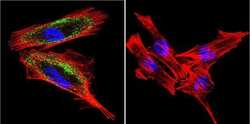
- Experimental details
- Immunofluorescent analysis of Hydrogen/Potassium ATPase beta using Anti-Hydrogen/Potassium ATPase beta Monoclonal Antibody (2G11) (Product # MA3-923) shows staining in A2058 Cells. Hydrogen/Potassium ATPase beta staining (green), F-Actin staining with Phalloidin (red) and nuclei with DAPI (blue) is shown. Cells were grown on chamber slides and fixed with formaldehyde prior to staining. Cells were probed without (control) or with or an antibody recognizing Hydrogen/Potassium ATPase beta (Product # MA3-923) at a dilution of 1:100 over night at 4°C, washed with PBS and incubated with a DyLight-488 conjugated secondary antibody (Product # 35503, Goat Anti-Mouse). Images were taken at 60X magnification.
- Submitted by
- Invitrogen Antibodies (provider)
- Main image
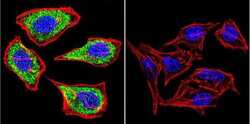
- Experimental details
- Immunofluorescent analysis of Hydrogen/Potassium ATPase beta using Anti-Hydrogen/Potassium ATPase beta Monoclonal Antibody (2G11) (Product # MA3-923) shows staining in Hela Cells. Hydrogen/Potassium ATPase beta staining (green), F-Actin staining with Phalloidin (red) and nuclei with DAPI (blue) is shown. Cells were grown on chamber slides and fixed with formaldehyde prior to staining. Cells were probed without (control) or with or an antibody recognizing Hydrogen/Potassium ATPase beta (Product # MA3-923) at a dilution of 1:200 over night at 4°C, washed with PBS and incubated with a DyLight-488 conjugated secondary antibody (Product # 35503, Goat Anti-Mouse). Images were taken at 60X magnification.
- Submitted by
- Invitrogen Antibodies (provider)
- Main image

- Experimental details
- Immunofluorescent analysis of Hydrogen/Potassium ATPase beta using Anti-Hydrogen/Potassium ATPase beta Monoclonal Antibody (2G11) (Product # MA3-923) shows staining in U251 Cells. Hydrogen/Potassium ATPase beta staining (green), F-Actin staining with Phalloidin (red) and nuclei with DAPI (blue) is shown. Cells were grown on chamber slides and fixed with formaldehyde prior to staining. Cells were probed without (control) or with or an antibody recognizing Hydrogen/Potassium ATPase beta (Product # MA3-923) at a dilution of 1:100 over night at 4°C, washed with PBS and incubated with a DyLight-488 conjugated secondary antibody (Product # 35503, Goat Anti-Mouse). Images were taken at 60X magnification.
- Submitted by
- Invitrogen Antibodies (provider)
- Main image
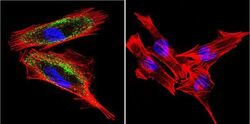
- Experimental details
- Immunofluorescent analysis of Hydrogen/Potassium ATPase beta using Anti-Hydrogen/Potassium ATPase beta Monoclonal Antibody (2G11) (Product # MA3-923) shows staining in A2058 Cells. Hydrogen/Potassium ATPase beta staining (green), F-Actin staining with Phalloidin (red) and nuclei with DAPI (blue) is shown. Cells were grown on chamber slides and fixed with formaldehyde prior to staining. Cells were probed without (control) or with or an antibody recognizing Hydrogen/Potassium ATPase beta (Product # MA3-923) at a dilution of 1:100 over night at 4°C, washed with PBS and incubated with a DyLight-488 conjugated secondary antibody (Product # 35503, Goat Anti-Mouse). Images were taken at 60X magnification.
- Submitted by
- Invitrogen Antibodies (provider)
- Main image
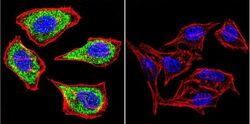
- Experimental details
- Immunofluorescent analysis of Hydrogen/Potassium ATPase beta using Anti-Hydrogen/Potassium ATPase beta Monoclonal Antibody (2G11) (Product # MA3-923) shows staining in Hela Cells. Hydrogen/Potassium ATPase beta staining (green), F-Actin staining with Phalloidin (red) and nuclei with DAPI (blue) is shown. Cells were grown on chamber slides and fixed with formaldehyde prior to staining. Cells were probed without (control) or with or an antibody recognizing Hydrogen/Potassium ATPase beta (Product # MA3-923) at a dilution of 1:200 over night at 4°C, washed with PBS and incubated with a DyLight-488 conjugated secondary antibody (Product # 35503, Goat Anti-Mouse). Images were taken at 60X magnification.
- Submitted by
- Invitrogen Antibodies (provider)
- Main image
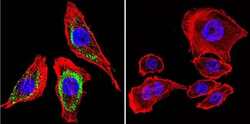
- Experimental details
- Immunofluorescent analysis of Hydrogen/Potassium ATPase beta using Anti-Hydrogen/Potassium ATPase beta Monoclonal Antibody (2G11) (Product # MA3-923) shows staining in U251 Cells. Hydrogen/Potassium ATPase beta staining (green), F-Actin staining with Phalloidin (red) and nuclei with DAPI (blue) is shown. Cells were grown on chamber slides and fixed with formaldehyde prior to staining. Cells were probed without (control) or with or an antibody recognizing Hydrogen/Potassium ATPase beta (Product # MA3-923) at a dilution of 1:100 over night at 4°C, washed with PBS and incubated with a DyLight-488 conjugated secondary antibody (Product # 35503, Goat Anti-Mouse). Images were taken at 60X magnification.
Supportive validation
- Submitted by
- Invitrogen Antibodies (provider)
- Main image
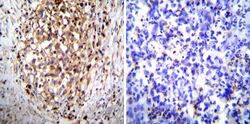
- Experimental details
- Immunohistochemistry was performed on cancer biopsies of deparaffinized Human gastric carcinoma tissues. To expose target proteins, heat induced antigen retrieval was performed using 10mM sodium citrate (pH6.0) buffer, microwaved for 8-15 minutes. Following antigen retrieval tissues were blocked in 3% BSA-PBS for 30 minutes at room temperature. Tissues were then probed at a dilution of 1:200 with a mouse monoclonal antibody recognizing Hydrogen/Potassium ATPase beta (Product # MA3-923) or without primary antibody (negative control) overnight at 4°C in a humidified chamber. Tissues were washed extensively with PBST and endogenous peroxidase activity was quenched with a peroxidase suppressor. Detection was performed using a biotin-conjugated secondary antibody and SA-HRP, followed by colorimetric detection using DAB. Tissues were counterstained with hematoxylin and prepped for mounting.
- Submitted by
- Invitrogen Antibodies (provider)
- Main image
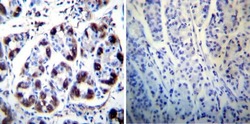
- Experimental details
- Immunohistochemistry was performed on normal deparaffinized Human stomach tissue tissues. To expose target proteins, heat induced antigen retrieval was performed using 10mM sodium citrate (pH6.0) buffer, microwaved for 8-15 minutes. Following antigen retrieval tissues were blocked in 3% BSA-PBS for 30 minutes at room temperature. Tissues were then probed at a dilution of 1:200 with a mouse monoclonal antibody recognizing Hydrogen/Potassium ATPase beta (Product # MA3-923) or without primary antibody (negative control) overnight at 4°C in a humidified chamber. Tissues were washed extensively with PBST and endogenous peroxidase activity was quenched with a peroxidase suppressor. Detection was performed using a biotin-conjugated secondary antibody and SA-HRP, followed by colorimetric detection using DAB. Tissues were counterstained with hematoxylin and prepped for mounting.
Supportive validation
- Submitted by
- Invitrogen Antibodies (provider)
- Main image
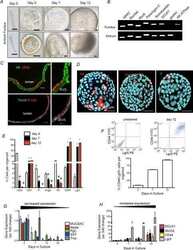
- Experimental details
- NULL
- Submitted by
- Invitrogen Antibodies (provider)
- Main image
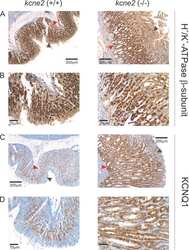
- Experimental details
- NULL
- Submitted by
- Invitrogen Antibodies (provider)
- Main image
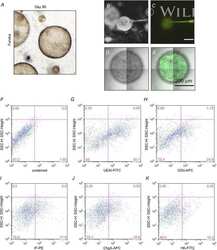
- Experimental details
- NULL
- Submitted by
- Invitrogen Antibodies (provider)
- Main image
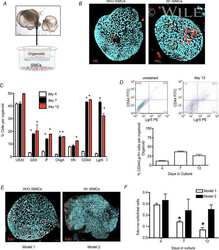
- Experimental details
- NULL
- Submitted by
- Invitrogen Antibodies (provider)
- Main image
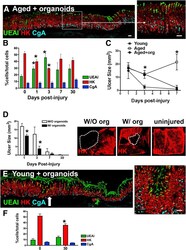
- Experimental details
- Figure 10 Organoid-derived SPEM cell lineages may contribute to wound healing in the aged stomach. ( A ) Immunofluorescence staining of ulcerated gastric tissue of aged mice transplanted with gastric organoids 30 days after injury. A lectin specific for surface mucous pit cells (UEAI, green) and antibodies specific for parietal cells (HK, red) and endocrine cells (CgA, blue) were used to identify cell lineages. Scale bars : 50 mum. ( B ) Quantification of UEAI+, HK+, and CgA+ cells within the damaged epithelium of aged mice transplanted with gastric organoids 1-30 days after injury. Data are presented as means +- SEM, N = 3-4 mice per time point. * P < .05 compared with day 0, determined by 1-way analysis of variance. ( C ) Ulcer measurements from young (black), aged (red), and aged mice transplanted with gastric organoids (green) at 1, 3, and 7 days after injury. Data are expressed as means +- SEM. * P < .05 compared with aged transplanted with organoids using 1-way analysis of variance, N = 3-10 mice per time point. ( D ) Ulcer measurements from young mice without (W/O) or with (W/) organoid transplantation at 1, 3, 7, and 30 days after injury. Data are expressed as means +- SEM. * P < .05 compared with young untransplanted mice using 1-way analysis of variance, N = 4 mice per time point. Whole mount immunofluorescence staining to identify parietal cells using antibody specific for H+K+-adenosine triphosphatase in stomach tissue collected from young mice without or with org
- Submitted by
- Invitrogen Antibodies (provider)
- Main image
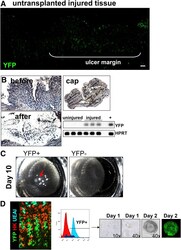
- Experimental details
- Figure 9 YFP expression in gastric epithelium of organoid transplanted mice. ( A ) Immunofluorescence staining using an antibody against YFP in untransplanted mice 7 days after injury. Scale bars : 50 mum. ( B ) YFP expression by RT-PCR using RNA prepared from laser capture microdissection of ulcerated and intact epithelium from stomachs 7 days after injury and gastric organoid transplantation. CAP, captured tissue. ( C ) Single cells flow sorted from stomach tissue of aged transplanted mice for YFP+ and YFP- grown in culture for 10 days. ( D ) Fluorescence-activated cell sorting (FACS) histogram depicting YFP+ single-cell population isolated from gastric tissue of aged mice transplanted with gastric organoids. YFP+ single cells were collected from the gastric glands 5 months after injury and gastric organoid transplantation and used to generate YFP+ gastric organoids in culture.
- Submitted by
- Invitrogen Antibodies (provider)
- Main image
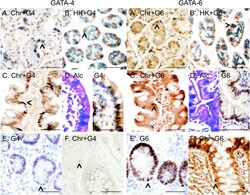
- Experimental details
- Figure 3 Identification of different cell types expressing GATA-4 and GATA-6 proteins in normal gastrointestinal mucosa . Staining for chromogranin A (ChrA) (blue-greyish cytoplasmic staining in A, A', C, C', F, and F') was used to detect neuroendocrine cells and staining for H+/K+-ATPase alpha (HK) (blue-greyish cytoplasmic staining in B and B' to detect parietal cells. The samples were double-stained for GATA-4 (G4) or GATA-6 (G6) (brown nuclear staining). The GATA proteins are not expressed in the neuroendocrine cells of the stomach, duodenum, or colon (A, A', C, C', F and F' respectively; arrowheads). GATA-4 is detected in the H+/K+-ATPase alpha presenting parietal cells (B). GATA-6 is positive in approximately two thirds of the parietal cells positive for H+/K+-ATPase alpha (B', arrowheads). Some duodenal goblet cells, stained deep blue by the Alcian blue method (Alc) (D'), and most Paneth cells are positive for GATA-6 (E', arrowhead) showing no immunoreactivity for GATA-4 (D and E, arrowheads). Scale bar = 50 mum.
- Submitted by
- Invitrogen Antibodies (provider)
- Main image
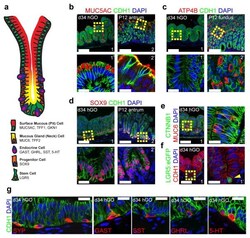
- Experimental details
- Figure 3 Human gastric organoids contain differentiated antral cell types a , Schematic representation of a typical antral gland showing normal cell types and associated molecular markers. b-g , Immunofluorescent staining demonstrated that 34-day hGOs consisted of normal cell types found in the antrum, but not the fundus. The hGO epithelium contained surface mucous cells that express MUC5AC ( b1, b1' ), similar to the postnatal day 12 (P12) mouse antrum ( b2, b2' ), but not ATP4B-expressing parietal cells ( c1, c1' ) that characterize the fundus ( c2, c2' ). SOX9 + cells were found at the base of the hGO epithelium ( d1, d1' ), similar to the progenitor cells found in the P12 antrum ( d2, d2' ). Further, hGOs contained MUC6 + antral gland cells ( e ) and LGR5 -expressing cells ( f ). Boxed regions in b-f are shown as high magnification images indicated by an apostrophe ('). g, Day 34 hGOs also contained endocrine cells (SYP) that expressed the gastric hormones GAST, SST, GHRL, and serotonin (5-HT). Scale bars, 100 mum in b-f , 20 mum in b'-f' and g . Marker expression data are representative from a minimum of 10 independent experiments, except LGR5-GFP data, which is a representative example from two separate experiments.
- Submitted by
- Invitrogen Antibodies (provider)
- Main image
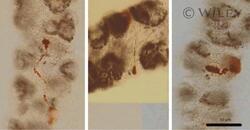
- Experimental details
- 4 Photomicrographs of double stained formalin-fixed, dispersed glands from the oxyntic mucosa, showing somatostatin-immunolabelled D-cells (stained red) and H + /K + ATPase-immunolabelled parietal cells (stained black). No connections between D-cells and parietal cells were seen. The cytoplasmic elongations were connected to other nonstained mucosal cells. For the double-staining technique, the cell smears were washed for 2 h in a glycine-HCL buffer (pH 2.2) between antibodies. Monoclonal Anti H + /K + ATPase Beta was used at a dilution of 1 : 2000 as a marker of parietal cells (MA3-923; Affinity Bioreagents, Golden, CO, USA). AEC peroxidase kit (SK4200; Vector) and a SG peroxidase kit (SK4700; Vector) were used to visualise the immunoreactions.
- Submitted by
- Invitrogen Antibodies (provider)
- Main image
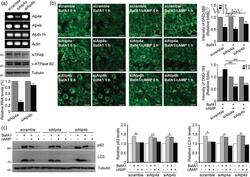
- Experimental details
- 3 FIGURE Possible involvement of H + /K + -ATPase in cAMP effects on lysosomal acidification: siRNAs. (a) Expression of H + /K + -ATPase in astrocytes and siRNA efficiency to Atp4a or Atp4b. RNA levels (upper panels) and protein levels (middle panels) of the subunits of H + /K + -ATPase (Atp4a and Atp4b) and Atp6 in astrocytes treated with scramble siRNA or siRNA for Atp4a or Atp4b for 72 hr. Expression levels of each RNAs were represented as a relative fold compared to those of cells treated with scramble siRNA (lower panels) ( n = 4, mean +- SEM, Student's t -test; *** p < .001). (b) Confocal photomicrographs of DND-189-loaded Atp4a or Atp4b knockdown (KD) astrocytes before and 1 hr after treatment with BafA1 or BafA1 plus cAMP (BafA1/cAMP). Cortical astrocytes were transfected with scramble siRNA or siRNA to Atp4a or Atp4b for 72 hr and DND-189 fluorescence changes in live cells were examined under a confocal microscope. The H + /K + -ATPase subunit-targeting siAtp4a or siAtp4b did not significantly affect lysosomal alkalization by BafA1 alone (left panels). In contrast, siRNA-mediated Atp4a or Atp4b KD attenuated the cAMP-mediated reversal of the effects of BafA1 (middle panels) (scale bar, 20 mum). Fluorescence changes in DND-189 were analyzed by the ""Mean ROI"" option in Zen software ( n = 3-9, mean +- SEM). * p < .05, ** p < .01, *** p < .001 versus control cells (one-way analysis of variance [ANOVA], one-tailed t -test); n.s., not significant, ### p < .001 (Kruskal-W
- Submitted by
- Invitrogen Antibodies (provider)
- Main image
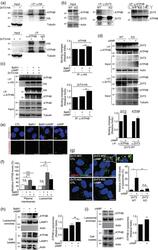
- Experimental details
- 6 FIGURE Increased association between H + /K + -ATPase and ZnT3 and their lysosomal recruitments by cAMP. (a) Immunoblotting for ATP4B and ZnT3-HA in anti-HA or anti-ATP4B antibody immunoprecipitates prepared from astrocytes transfected with ZnT3-HA for 72 hr. ATP4B was co-immunoprecipitated with ZnT3-HA (upper panels) and ZnT3-HA was co-immunoprecipitated with ATP4B (lower panels). Arrowheads show specific signals detected by each antibody and asterisk indicates the light chain of immunoglobulin. Experiments were repeated at least five times and representative images were shown. (b) Immunoblotting for ATP4B and ZnT3 in anti-ZnT3 or anti-ATP4B antibody immunoprecipitates in samples prepared from WT and ZnT3- (KO) astrocytes. ATP4B or ZnT3 was bound to each other at the cellular endogenous level. Arrowheads show specific signals detected by each antibody and asterisk indicates nonspecific bands (left panels, Input) or heavy chain of immunoglobulin (middle and right panels, IP). Experiments were repeated at least three times and representative images were shown. (c) Immunoblotting for ZnT3-HA and ATP4B in anti-HA or anti-ATP4B antibody immunoprecipitates from ZnT3-HA-transfected astrocytes after sham wash (CTL) or a 6-hr treatment with BafA1 alone or BafA1 plus cAMP. The addition of cAMP enhanced the association between H + /K + -ATPase and ZnT3. Arrowheads show ATP4B or HA by each antibody and asterisk indicates nonspecific bands (in input), light chain of immunoglobulin
- Submitted by
- Invitrogen Antibodies (provider)
- Main image
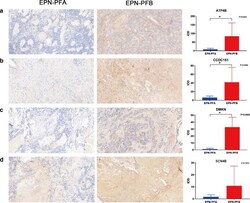
- Experimental details
- Fig. 7 Comparison of gene expression between two subtypes of EPN-PF. a Representative photomicrographs stained with ATP4B. The expression of ATP4B in EPN-PFB was significantly higher than that in EPN-PFA ( P = 0.0363). b Representative photomicrographs stained with CCDC151. The expression of CCDC151 in EPN-PFB was significantly higher than that in EPN-PFA ( P = 0.0280). c Representative photomicrographs stained with DMKN. The expression of DMKN in EPN-PFB was significantly higher than that in EPN-PFA ( P = 0.0003). d Representative photomicrographs stained with SCN4B.The expression of SCN4B in EPN-PFB was higher than that in EPN-PF, but the difference was no statistically significant ( P = 0.0363)
- Submitted by
- Invitrogen Antibodies (provider)
- Main image
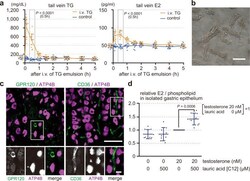
- Experimental details
- Fig. 4 Blood estrogen levels and production of gastric estrogen are directly regulated by blood triglyceride levels in males. a Male rats (8 weeks old, deprived of food for 4 h) were intravenously injected with soy oil emulsion (2 mL of 20 % soy oil emulsion per kg body weight, n = 10) or control saline (control, n = 10). TG and E2 levels in the tail venous blood were measured before (0) and at 0.1, 0.5, 1, 1.5, 2, 3, 4, and 5 h after the injection. b Isolated gastric gland epithelium from male rats. c Gastric mucosa of the male rat was double-stained for GPR120 (G-protein-coupled receptor 120) or CD36 (cluster of differentiation 36) (green) with ATP4B (magenta). d Isolated epithelium from male rat (deprived of food for 4 h) was incubated in DMEM with or without testosterone (20 nM) or lauric acid (500 uM) at 37 degC for 1 h. E2 levels, normalized by phospholipid, were compared to those incubated with 20 nM testosterone but without lauric acid ( n = 9). n number of rats. Data were mean +- s.d. a (0.5 h) and d , P values determined by two-sided Student's t -test. Bars: (main panels) 50 um; (insets) 10 um.
- Submitted by
- Invitrogen Antibodies (provider)
- Main image
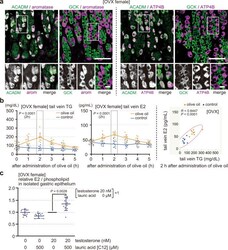
- Experimental details
- Fig. 5 Stomach of OVX female rats, like of male rats, secretes estrogen in response to the blood triglyceride levels. a Gastric mucosa from an OVX female rat (8 weeks old, operated 14 days before) was double-stained for ACADM or GCK (green) with aromatase [arom] or ATP4B (magenta). b OVX female rats, deprived of food for 4 h, were orally administered olive oil (2.5 mL per kg body weight, n = 9) or control water ( n = 9). TG and E2 levels in the tail venous blood measured before (0) and at 1, 2, 3, 4, and 5 h after the administration (left), and the correlation diagram between the blood TG and E2 levels at 2 h after the administration ( n = 18, right). c Isolated epithelium from OVX female rat (deprived of food for 4 h) was incubated in DMEM with or without testosterone (20 nM) or lauric acid (500 uM) at 37 degC for 1 h. E2 levels, normalized by phospholipid, were compared to those incubated with 20 nM testosterone but without lauric acid ( n = 10). n number of rats. Data were mean +- s.d. b left (2 h) and c P values determined by two-sided Student's t -test. b right, R and P values determined by Pearson's product-moment correlation with 95% density ellipse. Bars: (main panels) 50 um; (insets) 10 um.
 Explore
Explore Validate
Validate Learn
Learn